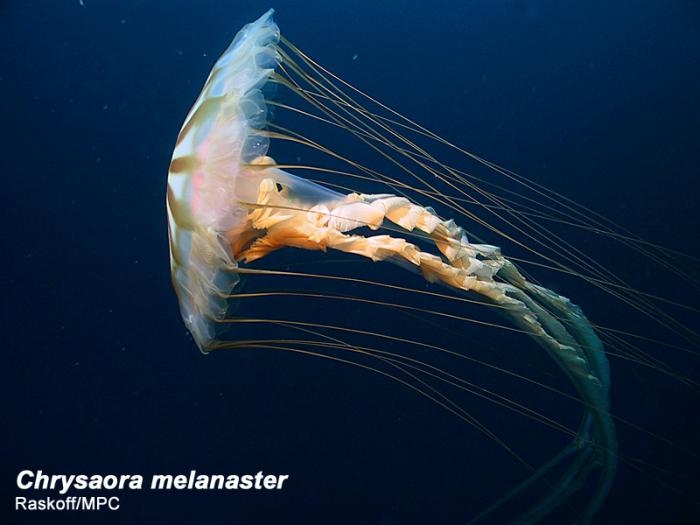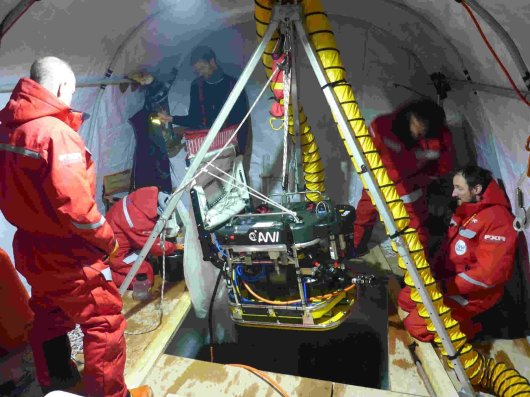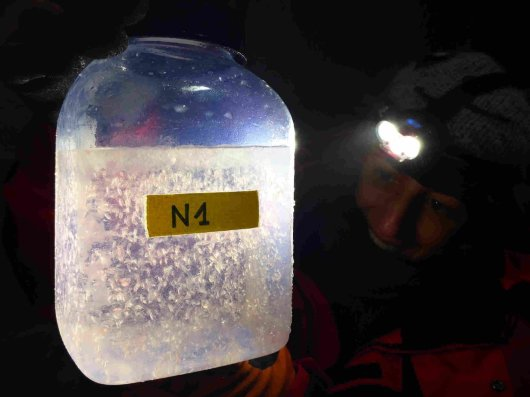There Are Fish!
On October 23, 2019 I posted a journal about the different strategies MOSAiC researchers were using to study fish in the Central Arctic Ocean. Studying these fish is challenging. Not only do the dark, cold, icy conditions make the work difficult, but when the MOSAiC expedition started there was little existing knowledge of which fish species or life stages were likely to be present in the waters around the Polarstern. As any fisherman will attest, is tricky to catch fish when you don't know quite what you are fishing for.
Well there is some news from the ice camp, and there is indeed life under the ice! Let's start with the zooplankton. Zooplankton describes animals that drift in the water with the currents or tides. Often, zooplankton can in fact swim pretty well. But what makes them zooplankton is that they can't swim strongly enough to outdo the effects of the currents.
 Sea jellies are a common type of large zooplankton. This species, called a sea nettle, is common in the Alaskan Arctic (Bering and Chukchi Seas as well as the Northern Gulf of Alaska). I'm not sure if jellies of any species are common in the Central Arctic Ocean. Hopefully MOSAiC will help us find out. Photo by Kevin Raskoff, Monterey Peninsula College.
Sea jellies are a common type of large zooplankton. This species, called a sea nettle, is common in the Alaskan Arctic (Bering and Chukchi Seas as well as the Northern Gulf of Alaska). I'm not sure if jellies of any species are common in the Central Arctic Ocean. Hopefully MOSAiC will help us find out. Photo by Kevin Raskoff, Monterey Peninsula College.
There are many types of zooplankton. Some are very small, and some, like sea jellies, can be larger than a person! Amphipods and copepods have hard exoskeletons like a crab or a shrimp. Other species of zooplankton can be very soft-bodied and delicate. When biologists try to collect zooplankton from the ocean, they have to decide what size of zooplankton and what type of zooplankton they want to focus on. This will determine the size and sometimes even color of the net they use, as well as how big the holes in the mesh of the net will be. In fact, researchers in the Northern Gulf of Alaska recently realized that they had been overlooking the role of jellies simply because of the plankton nets they were using. By deploying a special, bigger net that doesn't tear jellies into pieces as they are caught, researchers were able to get better estimates of jelly abundance and the diversity of jellies in the Northern Gulf of Alaska.
In addition to the type of net, biologists also have to decide how deep into the water to lower the zooplankton net. There are even special nets, called Multi-Nets, that are made up of multiple different nets of the same size, shape, and mesh size attached to a big metal box. Only one net is open at a time, and researchers use a computer program to open and close the nets at different depths. When the Multi reaches a specific depth range (like 200-150 meters), a computer signals the first net to open. Then the net is towed until it reaches the next target depth after enough water has passed through it. That net is then closed, and a second net is opened at the next shallower depth. So on and so forth, until the Multinet has collected a sample at each of the discrete depth layers in the water column. Using a Multinet means more nets to clean and samples to process, but sometimes it is worth it! The major advantage of the Multi is that researchers can get a better sense of what is happening at different depths in the water column, rather than lumping zooplankton over many meters of depth all together. I don't know if a Multinet has been used yet with MOSAiC. Carin Ashjian, a researcher from Woods Hole Oceanographic Institute will be using one soon during leg 3 of the expedition. Carin and her team will deploy the Multinet through the ice using strong cables from the Polarstern. They will lower it as deep as 2000 meters! Their hope is that this research will help them to better understand how the abundance, size, and reproduction of different zooplankton species are affected by changes in sea ice and light as spring approaches. This is a key to understanding how the ecosystem in the Arctic might be affected by climate change, and especially declines in sea ice.
 Researchers deploy the ROV with plankton net through a hole in the ice. This takes place inside a slightly-heated tent, which keeps the hole in the ice open and makes working conditions a little easier. Photo by Eric Brossier, courtesy Wageningen University & Research (2020).
Researchers deploy the ROV with plankton net through a hole in the ice. This takes place inside a slightly-heated tent, which keeps the hole in the ice open and makes working conditions a little easier. Photo by Eric Brossier, courtesy Wageningen University & Research (2020).
Other researchers have been [focused closer to the surface](](https://www.wur.nl/en/Research-Results/Research-Institutes/marine-research/show-marine/The-MOSAiC-expedition-continues-leg-2-Hardships-and-challenges-in-the-Arctic-winter.htm). Using an ROV (remote operated vehicle) biologists have towed a plankton net just below the sea ice. They have collected a number of different species of zooplankton. The zooplankton species include an abundance of copepods. These copepods they collected were likely living in the water around the sea ice, but some species are known to live in the brine channels within the sea ice. An orange amphipod they caught was eye-catching enough to be the "photo of the day" on February 2nd. Some amphipods feed in the water column, while others crawl along the bottom of the sea ice and eat different micro-organisms and algae at the base of the ice.
Biologist Robert Campbell focuses on the life cycle of copepods. During Leg 2 of MOSAiC, he used a net that goes down as deep as 2000 meters to collect plankton. Then he sorted through the zooplankton, looking especially for copepods. But his search didn't stop there! He looked more closely at each copepod, trying to find any females with eggs. This is like looking for a needle in a haystack!
 A sample of zooplankton collected during MOSAiC. Most of the animals in the jar are copeods. Photo by Eric Brossier, courtesy Wageningen University & Research, 2020.
A sample of zooplankton collected during MOSAiC. Most of the animals in the jar are copeods. Photo by Eric Brossier, courtesy Wageningen University & Research, 2020.
During the cold, dark winter, most Arctic copepods are in diapause. Diapause is similar to hibernation -- the copepods sink deep in the ocean, slow down, and survive off of their stores of fatty lipids. As spring comes around, many of the females produce eggs and the eggs float towards the surface. Robert is interested in learning more about how many eggs survive and how long it takes the eggs to develop to the first feeding stage of juvenile copepod. Luckily, he found a few females with eggs! He incubated these females in cold seawater and watched as the eggs were released and began to develop. Usually, females ripen and release their eggs later in the spring; this timing means that the young, hungry copepods are hatching near the surface just in time for the spring bloom of sea ice algae and/or phytoplankton. This ensures they will have plenty to eat. So why are some females ripe and ready to release their eggs in January? This is a bit of a mystery for now. Robert's research will hopefully help us to better understand how copepods might be affected by changes in timing of the spring bloom and if eggs released in January could be viable.
In addition to zooplankton, the researchers have also spotted fish! The ROV has taken many photos and videos of juvenile Polar Cod swimming just below the sea ice. These fish seem to be aware of the zooplankton net and swim away. As of the latest update (February 1) no Polar Cod had been caught yet with the ROV net. Hopefully, the other methods utilized by the fish researchers will be successful. It is great to know that they are present, but there are a lot of questions that can only be answered if the fish are caught. I'm interested in knowing: Do they have food in their stomachs? What are they eating? Do they have full stores of energy, or are they starving?
 Fish biologists are using a type of fishing gear called "long lines" to attempt to catch Polar Cod and other fish species that might be present. Photo by Esther Horvath, courtesy Alfred Wegner Institute (2020).
Education Extension
Fish biologists are using a type of fishing gear called "long lines" to attempt to catch Polar Cod and other fish species that might be present. Photo by Esther Horvath, courtesy Alfred Wegner Institute (2020).
Education Extension
We learned from Robert Campbell's research that copepod eggs are buoyant. Because of all the fatty lipids, they float to the surface. This strategy works for copepod eggs because they get trapped below the thawing sea ice. By the time the ice melts, the copepods have hatched and can swim. At least this is how it worked in the past, but some scientists are concerned that earlier melting of sea ice may mean the eggs bob all the way to the surface where they could dry out or be eaten by hungry birds. Similar, being really buoyant would be a problem for phytoplankton. They need to be in the water, not floating on top of it! But it is also a problem for phytoplankton if they sink too deep into the water away from sunlight. So most phytoplankton are neutrally buoyant -- this means they are about as dense as seawater. Most of the time, they neither float nor sink. In Plankton Races learners create their own model of plankton and strive to have it be as close to neutrally buoyant. This is a fun, wet activity and includes some great engineering practices!


Comments
Add new comment